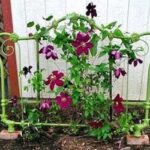The beauty of flower gardens has a timeless appeal, adding color, fragrance, and charm to any outdoor space. For those looking to create their own stunning flower garden, the availability of free flower garden designs and layouts can be a game-changer.
These resources not only offer inspiration but also practical guidance for designing and implementing a beautiful garden. From choosing the right location to selecting the perfect flowers and maintaining your garden’s health, there are many factors to consider when creating an outdoor oasis.
One of the first steps in designing a flower garden is determining the perfect location within your yard or outdoor space. Factors such as sunlight, drainage, and accessibility are vital considerations for ensuring your flowers thrive.
Selecting flowers that complement each other in terms of height, color, and bloom times is also essential for creating a cohesive and visually appealing garden. Additionally, finding budget-friendly design ideas and layouts can help bring your dream garden to life without spending a fortune.
In this article, we will explore the various aspects of designing an eye-catching flower garden while staying mindful of practical considerations such as budgeting and maintenance. Whether you’re a seasoned gardener or a novice with a green thumb, our tips and free design templates will guide you in creating a beautiful outdoor sanctuary that you can enjoy year-round. So let’s dive in and discover how you can turn your gardening dreams into reality.
Choosing the Perfect Location for Your Flower Garden
When planning to create a flower garden, one of the most crucial decisions is choosing the perfect location for it. The right spot will ensure that your flowers thrive and enhance the beauty of your outdoor space. Here are some essential tips for determining the best location for your flower garden.
Tips for Determining the Best Spot
First and foremost, consider the amount of sunlight your chosen spot receives. Most flowering plants require full sun, which means at least six hours of direct sunlight per day. Take note of any trees, buildings, or other structures that may cast shade on the area at different times of the day.
Considerations for Drainage and Accessibility
In addition to sunlight, it’s important to assess the drainage of the area. Avoid spots that are prone to flooding or have poor drainage, as this can lead to root rot and other issues. Accessibility is another factor to keep in mind. Choose a location that is easily accessible for watering, weeding, and tending to your garden without trampling on delicate flowers.
By carefully considering these factors, you can select a prime location for your flower garden that will set the stage for a successful and beautiful display of blooms.
Selecting the Right Flowers for Your Garden
The key to a beautiful and successful flower garden lies in selecting the right flowers for your specific space. When choosing flowers for your garden, it’s important to consider factors such as the local climate, soil type, and the amount of sunlight the area receives. Different flowers have different requirements, so taking the time to research and plan accordingly will result in a more cohesive and visually appealing garden.
One approach to selecting flowers for your garden is to choose a color scheme. Think about what colors will complement each other and create a harmonious overall look. For example, you might opt for a calming palette of blues and purples, or go for something more vibrant with fiery reds and oranges. Another option is to focus on one or two main colors and then use different shades and tones within that range.
In addition to considering color, think about the height, size, and bloom time of the flowers you choose. Taller plants can be used at the back of a border or mixed in with shorter plants for interest. It’s also worth considering when different plants will bloom – this can be planned strategically so that there are always blooms throughout the gardening season.
Lastly, don’t forget to take into account any special care requirements that your chosen flowers may have. Some plants need specific soil conditions, regular pruning, or protection from pests. Make sure you are aware of these needs before making your final selections.
| Flower Selection Tips | Data |
|---|---|
| Color Scheme | Choosing complementary colors or focusing on one main color with different shades |
| Height, Size, and Bloom Time | Considering how these factors will work together in your garden space |
| Care Requirements | Taking into account any special needs for soil conditions, pruning, or pest control |
Creating a Budget-Friendly Garden Design
Creating a beautiful flower garden doesn’t have to break the bank. With a little creativity and resourcefulness, it’s possible to design a stunning garden on a budget. Here are some tips for achieving a budget-friendly garden design:
- Repurpose materials: Instead of purchasing expensive garden borders or pathways, consider using recycled materials such as old bricks, wood pallets, or even rocks from your own yard.
- Shop smart: Look for sales at local nurseries or garden centers, and consider purchasing smaller plants that will grow over time rather than fully matured ones.
- DIY projects: Save money by taking on do-it-yourself projects such as building your own trellis or creating unique planters from repurposed containers.
By incorporating these budget-friendly ideas into your garden design, you can create a beautiful space without overspending.
Remember that creating a budget-friendly garden doesn’t mean sacrificing style or beauty. With a little ingenuity and effort, you can design a stunning flower garden that will bring joy and beauty to your outdoor space without breaking the bank.
Designing Your Garden Layout
Designing the layout of your flower garden is an important step in creating a visually appealing and functional outdoor space. A well-designed garden layout takes into consideration factors such as colors, heights, and bloom times to create a cohesive and harmonious look.
When planning your garden layout, it’s essential to think about how you want the space to be used and what kind of atmosphere you want to create. Do you want a peaceful retreat for relaxation, a vibrant and colorful spot for entertaining, or a combination of both?
Incorporating different colors, heights, and bloom times is key to creating visual interest in your flower garden. For example, consider planting taller flowers at the back of the garden bed and shorter ones at the front to create depth and dimension.
Additionally, mixing flowers with different bloom times ensures that your garden will have continuous color throughout the growing season. It’s also important to consider how different flower colors interact with each other – for example, complementary colors like purple and yellow can create an eye-catching display.
Another aspect to consider when designing your garden layout is functionality. Think about how you will move through the space and where you might want to place seating areas or other features. Creating pathways within your garden not only adds visual appeal but also provides easy access for maintenance tasks such as weeding and deadheading. Pay attention to traffic flow patterns to ensure that your garden is both beautiful and practical.
Lastly, don’t be afraid to get creative with your garden layout. Experiment with different arrangements of plants and pathways until you find a design that feels just right for your outdoor space.
| Aspect | Consideration |
|---|---|
| Colors | Mixing different flower colors for visual interest |
| Functionality | Careful consideration of traffic flow patterns for practicality |
| Creative Designs |
Maintenance Tips for Your Flower Garden
Maintaining a beautiful flower garden requires time, effort, and some basic know-how. By following these maintenance tips, you can ensure that your garden stays healthy and vibrant throughout the growing season:
- Regular Watering: Different types of flowers have different watering needs, so it’s essential to know the specific requirements of the plants in your garden. In general, most flowers need about an inch of water per week, either from rainfall or manual watering. It’s important to water deeply and less frequently to encourage deep root growth.
- Proper Fertilizing: Fertilizing your flower garden is crucial for promoting healthy growth and vibrant blooms. Use a balanced fertilizer with equal parts nitrogen, phosphorus, and potassium. Apply the fertilizer according to the instructions on the package, typically in the spring and again in midsummer.
- Pest Control: Keep an eye out for common garden pests such as aphids, slugs, snails, and caterpillars. Inspect your plants regularly for any signs of pest damage and take appropriate action to eliminate them. This may include using natural pest control methods or organic insecticides.
By implementing these maintenance tips, you can ensure that your flower garden remains a stunning focal point in your yard without requiring excessive time or resources. With proper care and attention to detail, you’ll be able to enjoy a flourishing garden throughout the growing season.
Free Flower Garden Designs and Layouts
Creating a beautiful flower garden doesn’t have to break the bank. In fact, there are plenty of free design templates and layouts available to help you get started on your gardening journey. Whether you’re a seasoned gardener or just starting out, these resources can provide inspiration and guidance for creating a stunning flower garden that suits your preferences and space.
Free Design Templates
There are numerous websites and gardening communities that offer free design templates for flower gardens. These templates often include detailed layouts, plant recommendations, and color schemes to help you visualize your garden. You can find templates for various styles of gardens, from cottage gardens to modern minimalist designs. By utilizing these free resources, you can save time and effort in planning your ideal flower garden.
Customizing Your Layout
While using a pre-made design template is a great starting point, don’t be afraid to customize it to fit your specific needs and preferences. Consider factors such as the climate in your area, the amount of sunlight your garden receives, and any existing landscaping features. Make adjustments to the layout, plant selection, and color scheme to create a personalized design that reflects your unique style.
Implementing Your Design
Once you’ve selected or customized a design template for your flower garden, it’s time to put your plans into action. Consider using affordable landscaping materials such as mulch or gravel for pathways, repurposing old containers as planters, or even propagating plants from cuttings to save on costs.
By implementing budget-friendly practices and techniques, you can bring your free design template to life without overspending. With some creativity and resourcefulness, you can enjoy the beauty of a well-designed flower garden without breaking the bank.
Conclusion
In conclusion, creating a beautiful flower garden is not only visually appealing but also offers numerous benefits for both the environment and individual well-being. Whether you are an experienced gardener or just starting out, the joy and satisfaction of seeing your carefully curated garden come to life are unmatched. By following the tips and free design templates provided, you can create a stunning flower garden that enhances the beauty of your home and provides a peaceful sanctuary for relaxation.
Furthermore, tending to a flower garden can be very therapeutic and mentally rewarding. The process of nurturing and caring for your plants can reduce stress and anxiety while also promoting mindfulness. Additionally, the presence of colorful blooms and the aroma of flowers can uplift moods and improve overall mental health. So, while you are enjoying the visual splendor of your garden, remember to also take some time to appreciate the calming influence it has on your state of mind.
In essence, there is no greater satisfaction than being able to step outside into your own personal oasis – a beautifully designed flower garden that reflects your creativity and love for nature. So, whether you have limited space or an expansive yard, let this guide inspire you to create a budget-friendly and enchanting flower garden that brings joy to both yourself and those who have the pleasure of experiencing its beauty.
Frequently Asked Questions
How Do You Layout a Flower Garden?
When laying out a flower garden, it’s important to consider the amount of sunlight, soil quality, and drainage in the area where you plan to plant. Choose a variety of flowers that bloom at different times of the year to ensure year-round color and interest.
You can create borders or clusters of flowers to add visual appeal and structure to your garden.
How Do I Arrange Flowers and Plants in My Garden?
When arranging flowers and plants in your garden, consider the height and spread of each plant so that they complement each other visually. Group together plants with similar water, sun, and soil requirements. Consider incorporating different textures and colors for an eye-catching display. Be sure to leave enough space for each plant to grow and thrive over time.
Is There an App to Plan a Flower Garden?
Yes, there are several apps available that can help you plan a flower garden. These apps often include features such as virtual garden planning tools, plant databases, growing tips, and design inspiration. Some popular gardening apps include Garden Plan Pro, iScape, and GrowIt!. Using these apps can make the process of planning your flower garden more organized and enjoyable.

Welcome to my gardening blog! I am passionate about plants and enjoy sharing my knowledge and experiences with others. In this blog, I will write about everything related to gardening, from tips on how to get started to updates on my own garden projects.





